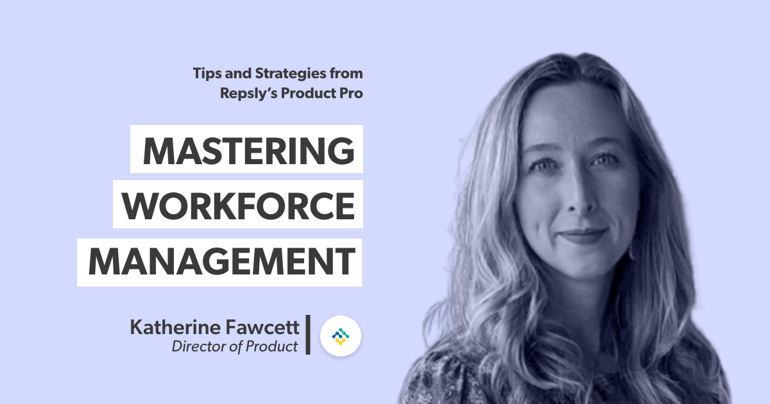Welcome to our new “Ask the Product Expert series” featuring none other than our resident product expert, Katherine Fawcett, Product Director at Repsly. She's here to answer your burning questions about our new Workforce Management (WFM) solution, which is basically a magic tool that helps businesses manage large, flexible teams and coordinate a high volume of activities for diverse initiatives. (Okay, maybe it's not magic, but it's pretty darn impressive.)
She'll cover the problems we're trying to solve in the market, the reasons behind our decision to develop the solution, and the specific needs and challenges of different types of businesses. Whether you're a manager trying to wrangle a team of reps, a rep looking for an easy-to-use system, or a client/report consumer who wants to make informed decisions based on data, Katherine has got you covered.
With her deep knowledge of the product and the market, she's uniquely qualified to help you understand how our solution can meet your needs and help your business succeed. So sit back, relax, and get ready to have all your WFM questions answered by the one and only Katherine.
What problems is Repsly trying to solve in the market with the new Workforce Management solution?
We’re seeing businesses struggle with trying to balance the needs of multiple stakeholders:
1. The manager who needs to distribute work, track completion, and analyze results - while also handling the other stakeholders.
2. The rep who is looking for ease of use and reliability. They need to be able to jump in with little to no training, easily find what they need to, get it done without issue, and get paid for it.
3. The client/report consumer who wants data presented in a format and cadence that works for them, and allows them to make informed decisions.
The more stakeholders involved, the more complicated it becomes. The solutions that worked for a team of 10, start to fray pretty quickly when applied to multiple teams across locales and business units. With increased volume in teams, brands, projects, regions, etc., comes the challenge of getting the right people to the right place at the right time. And if you’re trying to win business, you need to do it faster, cheaper and better than the rest! From this challenge, arises needs around assessing your talent pool, identifying your coverage for a market or project, scaling project management, increasing quality oversight, and more.
Overall, it is difficult for these companies to manage large, highly flexible teams, coordinate a high volume of activities for diverse initiatives and efficiently share the collected data and reports with different partners.
Why did Repsly decide to develop the solution?
Over the past few years, we’ve seen a few trends:
-
Whether for cutting costs, expanding for seasonality, or increasing coverage, we’re seeing more and more brands turn to merchandising service organizations to support their in-store operations. These organizations typically have a greater need for WFM than in-house teams.
-
A tight labor market means businesses need to devote resources to people management. This might mean identifying top reps to reward or underperforming reps to coach, ensuring you’re not overscheduling or under-scheduling reps, deploying resources efficiently, accurately routing and paying reps, etc.
-
With tight budgets and limited time, teams are looking to simplify their tech stack while simultaneously making it more powerful. Rather than using multiple systems and processes, they want a purpose-built one-stop-shop to not just deploy and analyze work, but to also manage those workers.
How are their needs different from CPGs?
Merchandising service organizations (MSOs), marketing agencies, brokers and auditors who are working on behalf of consumer goods brands are usually executing many of the same activities as in-house teams, but do have some unique needs given their structure:
-
Their work is often organized into client-specific projects and activities and needs to be reported in that way. They might be supporting two competing brands at the same time, so it’s critical to keep that data separate and presented in a way that works for each client. The data and reporting they share with their clients is really their end-product - how they win and retain business - and so it needs to be clean, timely, and secure. They want to act as a consultant to their clients and differentiate their business by providing better insights.
-
They often employ a high number of part-time workers or independent contractors. So while their business is retail execution, their operations are highly focused on workforce management. This can include hiring, training, coaching, scheduling, coordinating, reviewing, and paying reps. Since these reps may provide field services for multiple brands at a time, even during the same visit, time and activity tracking is essential for billing and compensation purposes.
-
Additionally, because their reps may have shorter tenure and significantly more context-switching as they do their jobs, having guardrails for quality control becomes even more essential. It’s never good when you find a junk photo a rep submitted, but it’s way worse when your client finds one! MSOs want more data quality built into the process to not only prevent mistakes and keep operations smooth, but ultimately to protect their reputation.
What does the roadmap ahead look like?
While we are continuing to invest in best-in-class data collection, analysis and sharing features, we are also building out more workforce management solutions to better coordinate complex labor flows with contract, full-time and part-time workers. A large focus for this year includes scaling for complexity, while increasing simplicity for the end user. Some areas we’re currently investing in include:
-
Amplifying project management to better organize different activities across brands, clients, teams and locations
-
Improving client and brand-based reporting
-
Coordinating workers to make sure they’re efficiently staffed and productive
-
Optimizing reps’ time in store so they can be as efficient as possible, particularly when balancing multiple projects, brands, and initiatives, even with little to no training




